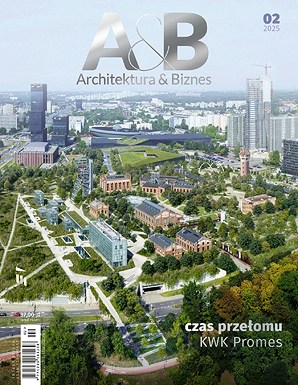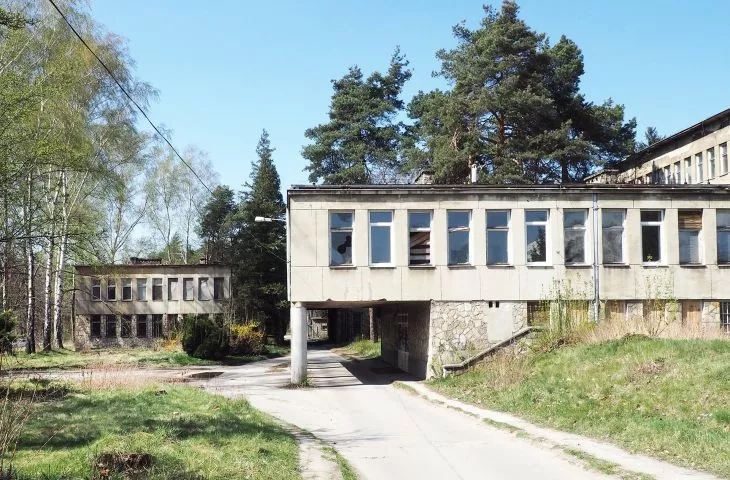Starachowice's former hospital building is one of the few such large and originally preserved monuments of modernism in the region and a unique opportunity for a small center to carry out a model revitalization of valuable heritage. The unique building has a chance to pass into the hands of the city and receive a new function.
Hope for change
photo by Kacper Kepinski
Starachowice, governed by Marek Materek, one of the youngest mayors of Polish cities, has for several years now become a field for many valuable initiatives at the intersection of revitalization, architecture and social animation. Included in the model revitalization program, the city now wants to take over the modernist building of the hospital in question from the district and use it for residential functions. The county council agreed at its last session to sell the post-hospital complex to the city. Negotiations on the price and details of the acquisition are still underway. Starachowice plans to use the site for municipal housing, expanding the housing base it has been developing for several years.
The modernist hospital building is part of the architectural heritage of the interwar period - a period of dynamic development in our city. It complements the architecture of Starachowice's colonies and residential neighborhoods. After revitalization - possible change of function and reconstruction to modern standards, it can be a notable example of protection and promotion of local cultural heritage.
Marcin Bednarczyk, Municipal Architect of Starachowice
A symbol of the glory days
photo by Kacper Kępiński
The decision to build the ZUS Hospital was made in 1936. The architectural design of the new edifice was entrusted to architect Ignacy Kedzierski, who was the chief architect of the city of Lublin in the interwar years. The project was approved in August 1939, and even before the outbreak of World War II, construction of the edifice began. The hospital building was put into use in 1950, and at the time it was one of the best-equipped medical facilities in Kielce region. The beginning of the end of the hospital building's history was the decision in the mid-1970s to build a new hospital according to a typical design. The official opening of the new building and the closing of the previous one took place on March 30, 2009, 27 years after construction began.
Scandinavian sanatorium in Kielce region
Photo: Ignacy Kedzierski / State Archives in Kielce
The existing building of the former hospital is a slightly transformed from the original, pre-war design, complex designed by Kedzierski. The essential part of the building is two slightly offset wings in relation to each other. From them, perpendicular to the south, two two-story pavilions were located. The longer of the two had an ambulance passageway, while the front of the shorter one was supported by columns, creating a covered driveway to the emergency department. Despite the northern exposure, the wing located to the rear in the central section received an individual facade design with lots of glazing, and the interior was shaped with variable ceiling heights and ramps - to create the best possible conditions in the operating rooms. An expressively shaped concave staircase wall was also located to the north. The eastern elevation also differs from the others. In the original documentation, arch. Ignacy Kedzierski indicated the possibility of expanding the hospital in this direction. All elevations have been carefully designed, with a clear rhythm of windows and a subtle drawing of elevation divisions made in noble plaster. An interesting accent, drawing on locally available materials, is the cladding of broken stone with which the ground floor of the building is finished. The entire complex is immersed in greenery with a heavily wooded character, giving the hospital an almost sanatorium-like expression.
Photo by Kacper Kepinski
The existing functionalist architecture of the former city hospital building is worth preserving due to its historical, architectural and urban planning values. This value was confirmed by the building's entry in the provincial register of monuments in the spring of 2017. Now there is a chance to restore the building to its former glory.
Live in a hospital
Possibilities for expansion of the hospital - Project of the Multigenerational Quarter in Starachowice
Photo: diploma thesis by Kacper Kepinski
Adaptations of post-hospital buildings can raise controversy over hygiene, the presence of viruses and bacteria, or, finally, the discomfort caused by living in a building where people also died. While the last argument depends on personal convictions and prejudices, the validity of concerns about hygienic conditions can be challenged scientifically, and examples of many hospitals that have already been adapted seem to best demonstrate the technical feasibility of adapting former medical facilities.
Examples of modern adaptations of former hospital buildings can also be found in Poland. Suffice it to mention the hospital building in Wawel Castle, part of which now houses apartments for museum employees. In Gorzow Wielkopolski, a technical school was set up in a former hospital building in 2012. In Gdansk, a developer took over the hospital site on Kieturakisa Street from the Gdansk Medical University in 2015. According to the design of the studio Grupa 5 Architekci, hotel and residential functions will be located in the historic buildings.
What does SANEPID have to say about it?
Photo: Chamielec Architekci / I2 Development
Work is underway in Wroclaw on the site of a defunct, historic 20th century hospital complex on Jana Pawla II Square to convert the buildings into lofts. The Chamielec Architekci office has designed 500 apartments at the site.
In the context of this investment, there has also been speculation in the local press about the safety of living in the former hospital buildings. In the pages of Gazeta Wroclawska, residents worried about germs in the old walls were reassured by a representative of the Sanepid:
"People very often have this perception of post-hospital buildings. However, there is very little chance for a bacteria or virus to survive without living matter. In new developments, as a rule, old plaster is scraped off. After the facility has been closed for several years, there is unlikely to be any chance of dangerous germs remaining indoors."
- says Magdalena Mieszkowska of the Provincial Sanitary and Epidemiological Station in Wroclaw.
Perspectives
The Spa House in Zegiestow undergoing renovation
Photo: Jakub Rodziewicz / National Institute of Architecture and Urbanism
Seeing the potential and exceptional value of the Starachowice hospital, one should therefore keep one's fingers crossed for its renovation and giving it a new function, respecting the historic fabric. The flexibility of Kedzierski's interwar design, which provided for the possibility of expanding or equipping the rooms with balconies, makes the adaptation possibilities extremely favorable. The hospital may thus become a model example of the revitalization of modernist heritage in a smaller center, once a strength of the city. Let's hope that it will soon share the fate of the żegiestow spa house designed by Adolf Szyszko-Bohusz, which is just rising from the ruins.
























































